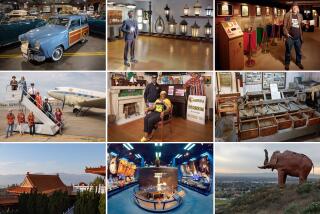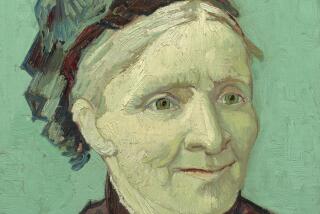It Pays to Come Clean, Curator Says
- Share via
The associate curator of decorative arts wears flip-flops.
He works with a stepladder, garden hose and naked chest. He puzzles over encrustation, oxidation, ball bearings, green splotches and the miserable things that automatic lawn sprinklers do to reclining nudes.
“This is not tartar buildup that we’re dealing with here,” William Chandler said solemnly as he zeroed in on a speck of alkali on an Alexander Calder--a fastidious hygienist in the gaping mouth of 20th-Century art.
Chandler is spending the softening days of late summer in the sculpture garden of the San Diego Museum of Art, rinsing, rubbing, polishing and waxing works of art by the likes of Henry Moore, Louise Nevelson, George Rickey and Joan Miro.
He is purging them of the depredations of weather, air pollution and the salt that drops with dew. Then there are the “dissolved solids” in the water from the sprinklers--pieces of the Rocky Mountains, Chandler has been given to understand.
Hodgepodge of Tools
His tools are something of a hodgepodge. He has a bucket, a large sponge, a steel stylus and various potions. He is an experienced polisher, tender of the museum’s Georgian silver collection. He has conferred with seers in the mysteries of metals conservation.
What questions needle at a sculpture cleaner?
“If you have an encrustation on a piece, what is it?” Chandler mused. “If it’s bronze sculpture and there’s green on it, what is it? Is that the way the artist intends it?”
And then, of course, there are logistical feats.
Take “Rickey’s Oblique Up: San Diego Variation.” It resembles a pared-down power-line pylon with two raised aluminum arms. On their tips, 15 feet up, tremble two giant aluminum chopsticks, moving slightly on ball bearings in the breeze.
“We discussed a cherry picker,” said Chandler, who plans to leave his thongs at home that day. But they settled on the museum’s hydraulic hoist cart, used for adjusting track lighting, to serve as Chandler’s chariot to the stars.
Then there’s “Nevelson’s Night Presence,” a massive collection of columns and shapes like chess pieces and a bird, all made of rusting steel. The steel was specially devised to rust on the surface, so steel wool is out. How will he clean it?
“Very carefully.”
Absorbed in the Work
Which is to say, wrapping each part in water-based poultices--tying damp cloths soaked in water to its many limbs. The poultices will gradually absorb contaminants and the piece will become clean without scrubbing.
“This is not like washing your car,” confided Chandler, who gives the task his total attention. “You have to pay attention to what you’re doing constantly. If I get clumsy and catch a rag on the molding of my car, I can live with that.”
Asked the value of the 27 sculptures he will be cleaning over the next two months, the associate curator was circumspect: “Our previous director had a nice way of putting it. He’d say, ‘More than a Mercedes but less than the space shuttle.’ ”
All in all, he enjoys the work. It’s an extension of summer for a man who usually toils in a basement. Visitors amble by on occasion and ask questions. From time to time, they make Chandler smile.
“My favorite comment came from a very nice lady who asked me if I was happy that I knew how to do this,” he remembered. “I said yes, I was. She shook her head.”
More to Read
The biggest entertainment stories
Get our big stories about Hollywood, film, television, music, arts, culture and more right in your inbox as soon as they publish.
You may occasionally receive promotional content from the Los Angeles Times.










